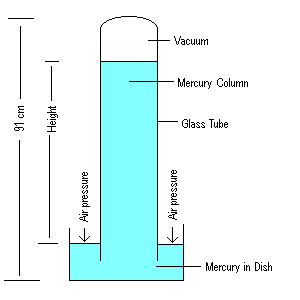|
|
|||||||||||||||||||||||||||||||||||||||||||||||||||||||||||||||||||||||||||||||||
|
Lesson 8 - Understanding Atmospheric Pressure - Page 2 |
|||||||||||||||||||||||||||||||||||||||||||||||||||||||||||||||||||||||||||||||||
|
Measuring Atmospheric Pressure Variations in atmospheric pressure impact a wide range of weather events, so meteorologists collect a great deal of data on atmospheric pressure to more accurately predict changes in climate. A simple, but accurate, instrument used to measure air pressure is the barometer, and sometimes the term "barometric pressure" is used instead of "atmospheric pressure" when these measurements are being discussed. |
|||||||||||||||||||||||||||||||||||||||||||||||||||||||||||||||||||||||||||||||||
| A
basic barometer is made with a tube sealed at one end and
a container of mercury. When the open end of the tube is immersed in the mercury, the pressure in the surrounding air forces the mercury up into the tube, and the height of the mercury in the tube can be measured to register changes in the pressure. However, these basic barometers take up a fairly large amount of space, and meteorologists presently use smaller instruments called aneroid barometers. An aneroid barometer is a sealed metal box placed in a vacuum. In the center of the box is a spring mechanism which is attached to the top and bottom of the box, which consists of thin corrugated plates. As the air pressure increases, these two plates are pushed together by the force, and the |
|
||||||||||||||||||||||||||||||||||||||||||||||||||||||||||||||||||||||||||||||||
| spring compresses. When
the pressure decreases, the plates move apart. The
movement of the top plate is transmitted to an
atmospheric pressure gauge, which translates themovement
into a measurement unit. For barometric pressure, the
standard unit is a millibar, and millibar measurements
correspond to the amount of mercury a given air pressure
supports. 1 millibar (mb) = 1/32 inch of mercury or 1
kilogram per square cm of surface area of mercury. So a
barometric pressure of 132 is reporting a pressure of
1013.2 millibars. Weather is very sensitive to changes in barometric pressure. What may seem a very small change in barometric pressure, such as a rise or drop of only 0.1 inch (2.5 mm) in six hours, will indicate that weather conditions will be changing very quickly. How the weather will change can be predicted in the rise or fall of the mercury levels: in cool dry weather, barometric pressure rises, and in warm wet weather, it drops. These indicators can signal high and low pressure ranges that dramatically impact whether a day will be fine with light breezes, or dark and stormy.
|
|||||||||||||||||||||||||||||||||||||||||||||||||||||||||||||||||||||||||||||||||
|
|||||||||||||||||||||||||||||||||||||||||||||||||||||||||||||||||||||||||||||||||
 Previous Page Previous Page  Next Page Next Page  IEMP Workbook Home IEMP Workbook Home |
|||||||||||||||||||||||||||||||||||||||||||||||||||||||||||||||||||||||||||||||||

